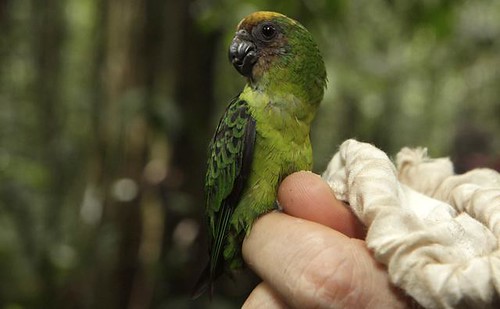 Pygmy parrots, as their name suggests, are the smallest members of the parrot family and are even smaller than budgerigars. There are six species which are found in the Solomon Islands and Papua New Guinea. Unusually for birds, pygmy parrots eat a lot of lichen and fungus as well as some seeds, fruit and insects. The tiny bird, which is not much bigger than an adult person's thumb, is smaller than some of the insects with which it shares the forest.
Pygmy parrots, as their name suggests, are the smallest members of the parrot family and are even smaller than budgerigars. There are six species which are found in the Solomon Islands and Papua New Guinea. Unusually for birds, pygmy parrots eat a lot of lichen and fungus as well as some seeds, fruit and insects. The tiny bird, which is not much bigger than an adult person's thumb, is smaller than some of the insects with which it shares the forest.
An expedition team filming in Papua New Guinea for the BBC programme Lost Land of the Volcano caught two of the buff-faced pygmy parrots on camera.
Another adult, which weighs less than half an ounce, was also trapped by the expedition team's bird expert.
On average, buff-faced pygmy parrots (Micropsitta pusio) stand less than 9cm tall and weigh 11.5g (0.41oz).
They are found across the northern lowlands of the island of New Guinea from the west to the southeastern tip, up to an altitude of around 800m.
Males and females look similar, but females have less prominent markings on the head.
The birds have green feathers with yellowish plumage on their underparts; while their cheeks, face, and crown are more buff-coloured, hence their name.
BBC wildlife cameraman Gordon Buchanan first discovered a tiny nest belonging to two parrots deep within pristine rainforest.
The birds nest in termite mounds, using their beaks and claws to dig their way in before laying eggs in the hole created.
Buchanan staked out the nest from within a camouflaged hide, and was rewarded after a long wait when two birds returned.
He filmed the pair at their nest entrance, as the male and female reinforced their bond by rubbing against one another.
Later, another parrot was trapped unharmed by Dr Jack Dumbacher, an ornithologist from the California Academy of Sciences in San Francisco, US, who had accompanied the BBC expedition team.
Buff-faced pygmy parrots do not eat fruit and nuts but lichen and fungi.
However, so little is still known about their dietary habits that it has proved difficult to rear the birds in captivity.
During the expedition, the team also managed to sight a rare Salvadore's duck (Salvadorina waigiuensis), a bird that is adapted to living in fast jungle streams.
The Salvadore's duck, or Salvadore's teal as it is also known, is the only duck species endemic to the island of New Guinea.
The International Union for the Conservation of Nature lists the bird as Vulnerable, and its total population may be slowly declining.
Other birds sighted included fruit doves that were completely naive to people, suggesting they had never been hunted in the past, and a king bird of paradise, with its crimson feathers, violet-coloured feet and a pair of tail streamers each ending with an emerald disc.
Correction 10 September 2009: Since the Lost Land of the Volcano programme was broadcast on Tuesday 8 September, we've learnt that this parrot may have been mis-identified. Ornithologist Dr Jack Dumbacher now believes the parrots filmed may be yellow-capped pygmy parrots (Micropsitta keiensis), not buff-faced pygmy parrots (Micropsitta pusio). At an average height of 9 to 9.5cm, the closely-related yellow-capped pygmy parrots are slightly taller than buff-faced pygmy parrots.